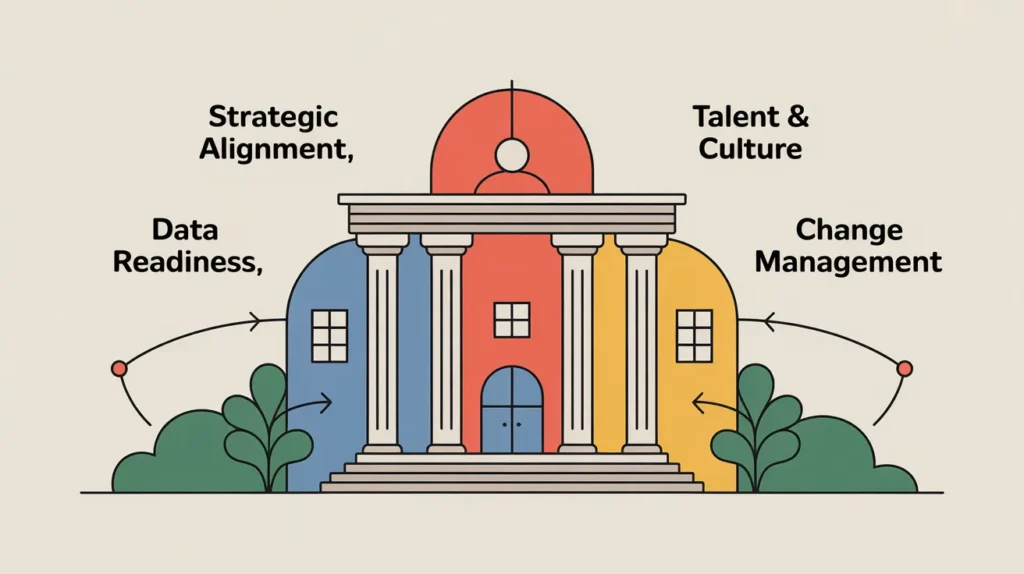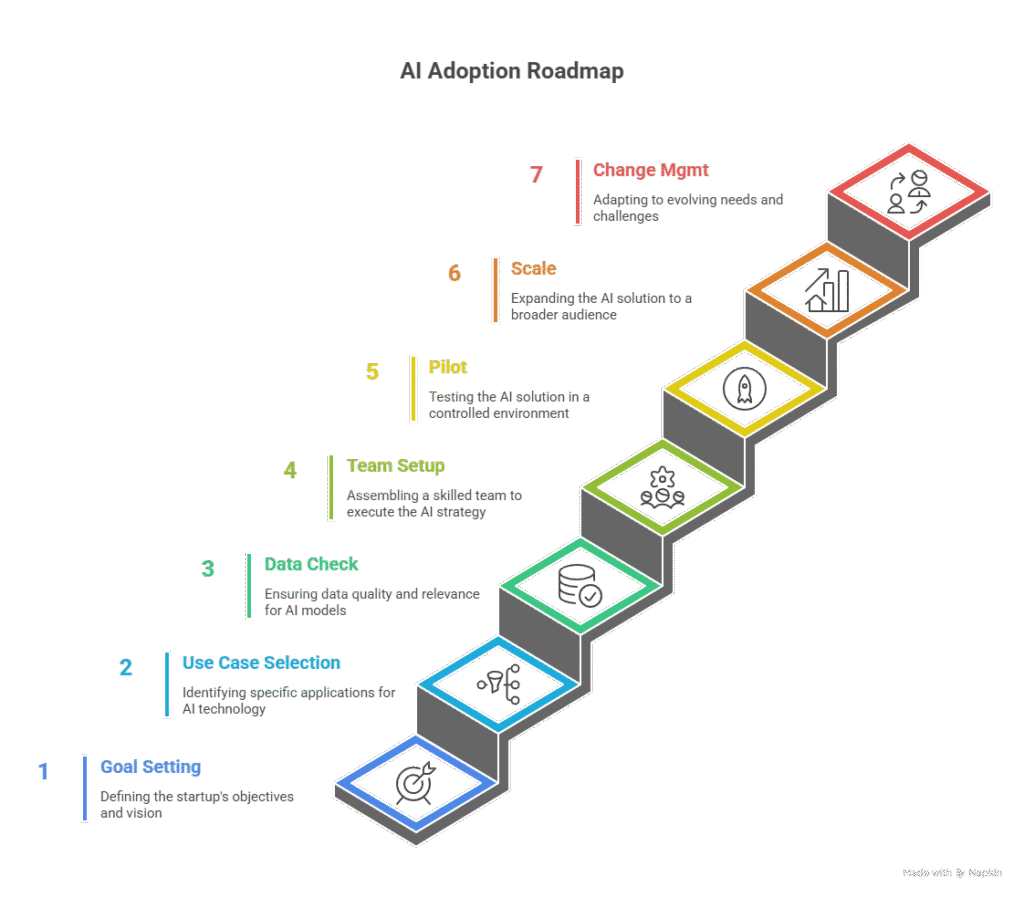Welcome, AI enthusiasts and business leaders! In this guide, I’ll break down everything you need to know about creating an AI strategy for business, which will be helpful for business leaders, with real-world examples, practical frameworks, and actionable checklists. I’ll share insights from my own readings and highlight what recent research and major institutions are saying. If you’re not a technical expert but want to unlock value from AI, you’re in the right place.
1. Why AI Strategy Matters?
Artificial intelligence is everywhere. But if you ask business leaders, the real question isn’t “Do you use AI?”—it’s “Are you using AI with a plan?”
Did you know? According to Harvard’s business strategy program, AI strategy for business leaders has become a cornerstone for companies aiming to get a real return on their tech spending. Without a clear roadmap, most companies end up either underusing AI or wasting money chasing “shiny object” tech that never sees a business result.

Quick Checklist: Is Your Organization Ready for AI?
- 1. Do you have a clear business problem AI can solve?
Example: Instead of “we want to use AI,” a retailer says, “we want to reduce customer returns by predicting which items are most likely to be sent back.”- 2. Do your teams understand AI’s benefits and risks?
Example: At a healthcare provider, staff attend a workshop on how AI can speed up patient scheduling (benefit), but also learn about patient privacy risks related to AI tools (risk).- 3. Is your data organized and accessible?
Example: A logistics company identifies that while they collect shipment data everywhere, it’s scattered in spreadsheets and cloud drives. They conduct a data audit and centralize their records before starting any AI project.- 4. Do you have buy-in from non-technical stakeholders?
Example: At a bank, the AI team partners with branch managers (not just IT) to ensure everyone understands how automated loan approvals will work, helping to drive trust and smooth adoption.
If you answered “no” to any, you’re in the right place. Let’s dive in!
2. What is AI Strategy?
An AI strategy is your comprehensive game plan for using artificial intelligence to create measurable business value—not just “doing AI for AI’s sake.” Think of it as your roadmap that connects AI technology to your business goals, ensuring every AI investment moves your company forward in a meaningful way.
Breaking Down What AI Strategy Really Means
It’s More Than Just Technology
Many people think an AI strategy is about choosing the right software or hiring data scientists. But that’s like saying a business strategy is just about having a computer and an accountant. AI strategy is fundamentally about business transformation—using intelligent technology to solve problems, create opportunities, and deliver value in ways that weren’t possible before.
What AI strategy is NOT:
- Buying AI tools because competitors are doing it
- Implementing AI in every department without a clear purpose
- Focusing only on the latest AI trends or “shiny objects”
- Leaving AI decisions entirely to your IT department
- Expecting immediate, magical results from AI investments
What AI strategy IS:
- A deliberate plan connecting AI capabilities to business outcomes
- A framework for making smart decisions about where and how to use AI
- A systematic approach to building AI capabilities over time
- A cultural shift toward data-driven, intelligent decision-making
- A competitive advantage that compounds over time
Four Pillars of AI-Driven Business Transformation
Think of these four pillars as the foundation of your house. Skip one, and the whole structure becomes unstable. Each pillar supports the others, and together they create a solid base for your AI journey.

1. Strategic Alignment
- Make sure every AI project is tied to a core business goal. IBM says the best strategies “align AI initiatives with overall business objectives”—whether that’s growth, efficiency, or new products.
2. Data Readiness
- Clean, organized data is your foundation. No matter how smart your AI is, if the data is a mess, the outcome will be disappointing.
3. Talent & Culture
- You don’t need a company full of PhDs, but upskilling your team, hiring selectively, and encouraging cross-team collaboration are vital.
4. Change Management
- AI shakes up routines. Success comes when everyone—from finance to HR to operations—trusts and adopts the new way of working.
Framework: When I read the Harvard Business guide and IBM’s insights, they always focus on integrating these four pillars rather than just investing in tech alone.
3. Why AI Needs Business-Level Strategy (Not Just Tech)
AI is not just about fancy algorithms. It’s a tool for real business value—if you focus beyond the technology itself.
Case Study: I recently read how Shell uses predictive AI analytics to optimize drilling. Instead of just rolling out tech company-wide, the project started with business leaders pinpointing safety and efficiency as top priorities. Only then did the tech team build AI into operations, saving millions.
Top Pitfalls of Tech-Led AI Initiatives
| Pitfall | What Happens |
|---|---|
| Lack of business alignment | AI projects stall or never deliver business value |
| Poor stakeholder buy-in | “Quick wins” prove slow, and people lose trust |
| Unrealistic expectations | AI gives nonsense results, and leaders lose faith |
| Data chaos | AI gives nonsense results, leaders lose faith |
| Ignoring change management | Staff gets overwhelmed, project fizzles |
Is Your AI Project Aligned with Business Objectives?
- Does project success directly impact KPIs you already track (like revenue, customer NPS, cost savings)?
- Can leaders outside IT explain the business benefit?
4. Who Drives AI in the Business?
When it comes to making AI work in any organization, it’s not about having secret algorithms or a magic technical formula. AI success is first and foremost about people.

Think of your AI journey like building a winning sports team:
You need diverse talents, clear roles, and total buy-in. If you leave key players on the sidelines, you risk fumbling even the smartest solutions.
The Essential Players on Your AI Team
1. Executives:
Set the vision, unlock budgets, and remove roadblocks
Your leaders must be the champions of change. They clarify why AI matters, give the project visibility, and commit resources—without their support, your efforts can stall out before they begin.
2. Operations:
Understand day-to-day processes, identify real opportunities
The people running your core business functions know where the pain points and opportunities are. They help spot the practical use cases where AI can make a measurable difference.
3. HR & Talent:
Develop skills, drive adoption, build team confidence
HR isn’t just about hiring—it’s about upskilling. Their support ensures your team stays confident, informed, and open to working alongside AI tools.
4. Finance:
Keep an eye on ROI and ensure long-term viability
Finance teams track value. They ask, “Is this project delivering on its promise?” and keep you honest about costs, risks, and business benefits.
5. IT & Security:
Build the foundation, ensure safe and robust systems
IT and security teams bring technical expertise and make sure your systems are reliable, secure, and scalable. They also ask tough questions about data privacy and system integration.
Real-Life Lesson: Success Needs Cross-Functional Champions
Here’s an eye-opener from a recent industry report:
A major US retailer wanted to overhaul their inventory management using AI. At first, IT led the project alone. They built a technically strong tool, but almost nobody used it, and overall costs didn’t budge.
What changed? When the retailer invited operations and sales teams to join the project, everything shifted. These frontline teams brought practical insights: which inventory issues mattered most, how store staff actually worked, and where AI could be integrated smoothly. The result? The company slashed stock costs by 15% within a year, just by having all the right people at the table.
The takeaway:
Successful AI isn’t something you hand to just one department. The earlier you engage every key stakeholder, executives, operations, finance, HR, and IT, the more value you unlock. Involve everyone from the start and watch your chances of ROI soar.
5. Practical AI use cases for different industries
AI is not “just for tech companies.” Here’s how it adds value, with real-world examples.

AI by Business Function
- Customer Service: Chatbots, 24/7 support, personalized help.
- Sales & Marketing: Lead scoring, campaign optimization using AI analytics.
- HR & Talent: Resume screening, attrition prediction, diversity analysis.
- Operations: Automated scheduling, workflow automation.
- Finance: Real-time fraud detection, forecasting.
- IT & Security: AI-powered anomaly detection and cybersecurity.
According to a study I read on LeewayHertz, nearly every sector now shows strong value from practical AI applications.
Related Post: AI Is Seriously Transforming These Business Areas—Are You Missing Out?
6. How to implement AI in business step by step Roadmap
Let’s cut through the jargon. Here’s a practical “AI adoption roadmap for non-technical managers,” drawn from step-by-step guides I’ve reviewed from Harvard, Coursera, and leading AI firms:

Step 1: Define Clear Goals – “What problem are we solving?”
AI is not magic—it won’t fix everything. You need to start by asking:
👉 “Where is my business struggling?”
👉 “Where can AI help us win?”
✅ Examples:
- A retail shop wants to predict which products will sell next month so they don’t overstock.
- A restaurant wants to reduce food waste by forecasting how many customers will come each day.
- A real estate agency wants to automatically respond to basic customer questions (like “Is this property still available?”).
📌 Tip: Don’t start with vague goals like “Let’s do AI because it’s trending.” Start with a business pain point or opportunity.
Step 2: Prioritize Use Cases – “What’s doable now?”
Once you list possible AI ideas, rank them using a simple 2×2 grid:
- High Impact & Easy to Do → Start here
- High Impact but Hard → Plan for later
✅ Examples:
- Quick Win (Easy): Use an AI chatbot to answer FAQs on your website.
- Later Project (Harder): Build an AI model to predict market trends 2 years in advance.
📌 Tip: Start with something small and visible—a “quick win.” This builds confidence in AI before you invest big.
Step 3: Assess Data Readiness – “Do we have the fuel for AI?”
AI runs on data like cars run on fuel.
👉 Do you already collect enough data?
👉 Is it clean and organized—or messy and scattered?
✅ Examples:
- If you run a bakery but don’t track daily sales, an AI can’t predict demand. You’ll first need to start logging sales by day.
- If you have a CRM (customer database) but it’s full of duplicate emails or missing phone numbers, clean it before using AI.
📌 Tip: Many AI projects fail here because the company discovers its data is messy. Fixing data first saves headaches later.
Step 4: Build the Right Team – “Who will make this happen?”
You don’t need to hire 10 data scientists tomorrow.
- Upskill your current team (e.g., train your marketing staff on how to use AI tools).
- Bring in outside help for what’s too complex (consultants, agencies, or AI vendors).
✅ Examples:
- A clothing brand trained its in-house designers to use AI tools for creating design mockups.
- A small hotel hired a freelance AI consultant to set up an AI chatbot instead of building an entire tech team.
📌 Tip: Think “blended team”—existing employees + trusted partners.
Step 5: Start with a Pilot – “Test before going all in.”
Instead of rolling AI across the whole business, test it on one small, safe project.
✅ Examples:
- A gym runs an AI pilot that predicts which members might cancel memberships—then tests if special offers can keep them engaged.
- A local shop tries an AI tool to auto-categorize products for their online store—instead of trying to automate the entire inventory system from day one.
📌 Tip: Keep pilots time-limited (4–8 weeks) and measure results (Did sales go up? Did costs go down?).
Step 6: Scale and Optimize – “What worked? Do more of that.”
If the pilot worked, expand it step by step.
👉 Share success stories across the team.
👉 Keep tweaking the AI based on real results.
✅ Examples:
- A restaurant tested AI to forecast weekend demand—once it worked, they expanded it to weekdays too.
- A retail chain used AI to recommend products online—then rolled it out in physical stores using digital kiosks.
📌 Tip: Scaling doesn’t mean “copy-paste.” Each new area might need slight adjustments.
Step 7: Ongoing Change Management – “Support the people, not just the tech.”
AI isn’t just about tools—it’s about how people work with them.
👉 Train staff.
👉 Celebrate wins (so people don’t feel “AI is here to replace me”).
👉 Keep learning as AI evolves.
✅ Examples:
- A bank created a monthly “AI update session” for employees to learn what’s new and ask questions.
- A retail team celebrated when AI reduced customer returns—making staff feel like they “won” with AI, not against it.
📌 Tip: Make AI adoption a team journey, not a top-down order.
A CEI America blog I read highlights these seven steps as the backbone of successful AI strategies. My own experience? Businesses that rush and try to “do it all at once” almost always fail.
Related Post: AI Implementation Roadmap: A Non-Technical Leader’s Guide to Turning Bold Ideas into real wins.
7. Common Pitfalls and Lessons Learned
Let’s be honest: most AI projects don’t deliver real business impact at first. Here’s why (and how you can beat the odds):

Top 5 Pitfalls (and Solutions)
- Unclear objectives
- Lack of cross-team collaboration
- Data issues
- Underestimating change management
- Expecting instant results
- Solution: AI takes time—pilot, measure, improve.
Case Study Box: Deloitte found that while 90% of executives invest in AI, only about 30% realize significant value in the first year. The companies that succeed? They’re the ones who set realistic expectations, invest in change management, and align projects with business objectives from the beginning.
8. Frameworks, Checklists, and Resources
Here are tools you can use, plus where to find more:
AI Strategy Preparation Checklist
- Defined a clear business objective
- Data sources identified, quality checked
- Stakeholder team formed cross-functionally
- Quick-win pilot chosen and mapped
- Measurement KPIs selected (ROI, customer NPS, efficiency, etc.)
- Change management plan in place
- Responsible AI/ethical guidelines drafted
Responsible AI Framework Examples
- Set rules for fairness, privacy, and transparency
- Regular audits for bias or discrimination
- Document decisions for accountability
Ways to Measure ROI
- Set clear, quantifiable objectives before you start
- Identify key metrics (cost savings, revenue, process speed, customer feedback)
- Collect baseline data before rollout
- Compare results post-implementation
- Adjust and scale up based on data
Related Post: Is Your AI Worth It? How to Track AI ROI with Real-World Examples
9. Conclusion & Next Steps
Building an AI strategy for business leaders doesn’t require deep tech skills—but it does require clear goals, teamwork, and patience. Every successful project I’ve read about, from major manufacturers to nimble startups, started with a clear business outcome in mind, built on a foundation of good data and cross-team collaboration.
Frequently Asked Questions (FAQs)
Q: How do I make sure our AI isn’t just “tech for tech’s sake?”
A: Always tie your project to a measurable business outcome—a clear goal, KPI, or operational improvement you can communicate to your whole team.
Q: What if our data is messy or incomplete?
A: Nearly every guide and case study I’ve read—especially the ones from IBM and Harvard—emphasizes the importance of a data audit as a first vital step. Clean up before you build!
Q: Do I need technical talent in-house?
A: Not at first. Many organizations succeed by upskilling a few key people and partnering with service providers, then hiring as needs grow.
Q: How long does successful AI implementation take?
A: The timeframe can range from a few months for a small pilot project up to several years for deep transformation. Prioritizing “quick wins” helps maintain momentum and build buy-in from stakeholders.
Final Thoughts
AI is not a magic bullet—it’s a strategic tool. Approach it as a business leader: start with your goals, build your team, invest in data, and embrace change management. You’ll be far ahead of the “cool tech” crowd, creating real value and a competitive edge in your industry.
If you want to dig deeper, check out the resources and cluster posts linked above—each dives into specialized roadmaps, industry guides, or ROI frameworks so you can turn insights into action.
According to Harvard, IBM, and McKinsey, the companies winning with AI in 2025 are those that “think business first”—and that can be you!
Also Read: AI Ethics and Responsible AI: An Easy Guide for Everyone







Pingback: OpenAI’s ChatGPT Explodes to 700 Million Weekly Users, Raises $8.3 Billion to Supercharge Its AI
Pingback: AI Is Seriously Transforming These Business Areas—Are You Missing Out?
Pingback: The AI Blueprint: 4 Pillars Every Future-Ready Business Needs
Pingback: Is Your AI Worth It? How to Track AI ROI with Real-World Examples